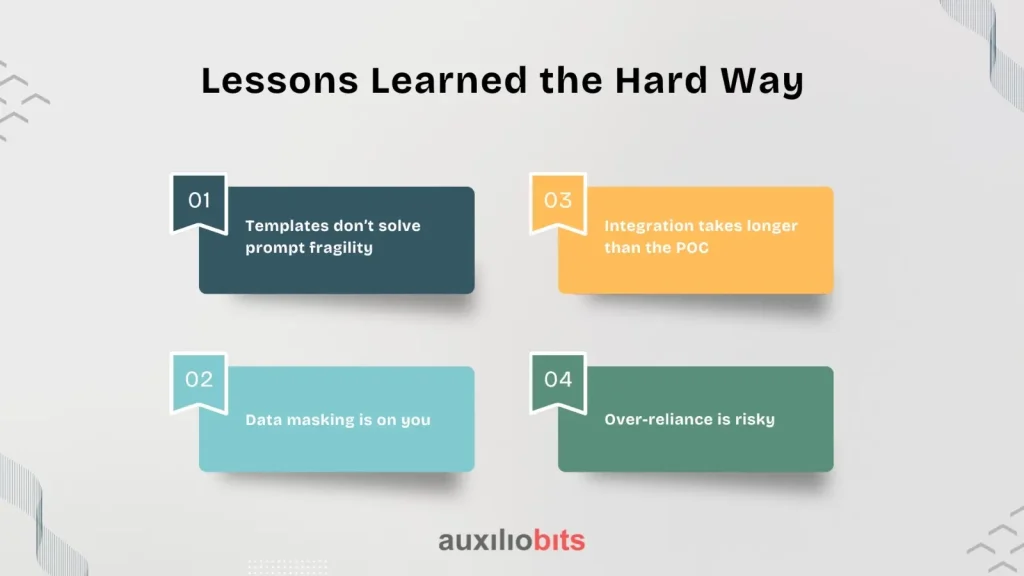
Key Takeaways
- LangChain templates excel at filling automation gaps — They target the 20% of repetitive, manual work left over after core systems like CMS, ERP, or HRIS handle the basics.
- They act as the “thinking layer,” not the intelligence or the glue — LangChain organizes reasoning, retrieval, and routing between tools so LLMs can work reliably in production.
- Industry-specific templates can accelerate real results — In claims, procurement, and HR, they cut down processing time, reduce manual lookups, and improve data routing without replacing human oversight.
- Templates are accelerators, not turnkey solutions — They help with ingestion, retrieval, and structured outputs, but still rely on clean data, integration work, and process understanding.
- Long-term success depends on ownership and adaptability — Treating templates as black boxes risks breakage; continuous testing, prompt tuning, and integration maintenance are essential.
Here’s the thing about enterprise automation—it’s never the “blank canvas” problem you’d expect. Most organizations already have a claims management system, a procurement portal, or an HRIS that does 80% of what’s needed. The real problem is the 20% of work that slips through: the Excel cleanups, the email chases, and the copy-paste rituals from PDF to form.
And that’s where LangChain templates find their niche. They’re not magic, but they do stop your engineering team from losing three weeks on “How should we chunk these documents again?” or “What’s the cleanest way to pass an intermediate state between agents?”
If you’ve tried wiring an LLM to a production workflow without a template, you already know the pain:
- The model answers beautifully… until it forgets the context from two turns ago.
- A contract search pulls every clause from a 200-page PDF instead of the one you need.
- Output formatting breaks the moment someone changes a field name.
Templates aren’t glamorous. But they handle those basics so you can focus on the tricky stuff.
Also read: Using LangChain to Build Context-Aware Business Process Agent.s
LangChain’s Role—Not the Brain, Not the Glue, but Something in Between
People love to frame LangChain as “the AI framework,” but that’s overselling it. It’s not the intelligence—the LLM does that. It’s not the integration glue—your APIs and middleware do that. It’s the middle layer that organizes thinking, memory, and retrieval, so the model doesn’t act like a distracted intern.
Think about:
- Chaining reasoning steps so the model doesn’t hallucinate a claim number that doesn’t exist.
- Routing requests to the right tools without a dev hardcoding if/else trees.
- Handling retrieval so you don’t need to re-index every time someone uploads a new compliance policy.
If you’ve ever had to debug a procurement agent that’s returning the wrong supplier file because of poor retrieval logic, you’ll know why this layer matters.
Claims Processing: From Intake to “Case Closed”
The messy reality: Insurance and warranty claims aren’t just “receive, verify, pay.”
You’ve got:
- Photos are missing from the submission.
- Policies written in legalese that even the claims officer has to squint at.
- Medical reports that arrive as scanned faxes. Yes, still.
Where the LangChain template earns its keep:
A claims-specific template usually has:
- A document ingestion layer that doesn’t choke on mixed file types.
- Retrieval tuned for precision, not “dump the entire PDF into context.”
- Conditional logic for routing: suspected fraud, high-value claims, expedited cases.
- A structured output parser so the claim data feeds cleanly into your CMS.
A real-world example:
One Canadian insurer rolled out a LangChain-based claims intake assistant. Within six weeks:
- Routine claims under $5K were auto-drafted for approval.
- Missing details were auto-requested from customers with pre-filled forms.
- The policy clause matching reduced manual review time by a third.
And yes—the adjusters still made the final call. But their average claim touch time dropped from 28 minutes to 17. That’s the kind of win you can take to the CFO.
Procurement: The Forgotten Middle Layer of Automation
Procurement automation is like plumbing—no one notices until it fails. And fail it does, usually in the form of:
- Vendor records are missing a tax ID.
- Renewal clauses that get overlooked until you’re stuck paying another year for unused software.
- Risk checks that live in an analyst’s head instead of a system.
What a procurement LangChain template usually wires up:
- Data extraction from supplier forms and contracts.
- Compliance database cross-checks.
- Vector search for contract clauses, so you can ask “Which suppliers have a 30-day termination window?” without digging through shared drives.
- Alert triggers for upcoming renewals.
Where it gets interesting:
One manufacturing company I worked with had over 2,000 active suppliers. They used a template-based LangChain agent to:
- Score vendors based on delivery delays, quality issues, and even public sentiment data.
- Surface “watch list” vendors to procurement leads weekly.
It didn’t replace supplier managers. It made them stop wasting Mondays digging through CSV exports.
HR Operations: The Quietly Expensive Processes Nobody Tracks
HR automation gets less attention than claims or procurement because it’s “internal.”
But if you’ve run the numbers, you know: the cost of repetitive HR queries and policy clarifications adds up fast.
1. Employee onboarding Q&A
Every new hire gets the same 30-page welcome packet. And still, they’ll email HR:
- “How many sick days do I get?”
- “What’s our work-from-home policy?”
- “Who approves travel expenses?”
With a retrieval-augmented Q&A template:
- All documents are indexed once.
- The bot answers with the exact clause and page reference.
- HR sees the questions being asked most often and updates the docs accordingly.
2. Policy compliance assistants
hen a mid-year policy update drops, sending an email isn’t enough. A LangChain-driven bot can walk employees through “what’s changed” in plain English, tailored to their role.
3. Performance review
No, AI shouldn’t write the review — but it can gather project outcomes, peer feedback, and KPIs so a manager isn’t staring at a blank form.
Where Templates Shine—and Where They Fall Flat?
Shine:
- Fast proof-of-concept without weeks of plumbing.
- Consistent retrieval logic across departments.
- Lower barrier for teams new to LLM engineering.
Fall flat:
- Complex payout calculations in claims—still better done in a rules engine.
- Workflows with garbage input data (templates can’t make bad PDFs readable).
- Scenarios needing absolute traceability—LangChain logs aren’t always audit-grade.
Lessons Learned the Hard Way H2
A few things you won’t see in vendor brochures:

1. Templates don’t solve prompt fragility
Change a few words in your prompt, and the model output shifts. You still need regression testing.
2. Data masking is on you
LangChain won’t automatically strip out SSNs from a supplier onboarding file.
3. Integration takes longer than the POC
Getting your agent’s output back into SAP or Workday without breaking validation rules is the real bottleneck.
4. Over-reliance is risky
If your team treats the template as a black box, one LangChain update can break your flow.
Closing Remarks
LangChain templates are scaffolding. They’re not the building, and they’re not the architect. They’re best used as accelerators for processes you already understand deeply.
In claims, procurement, and HR, they save time—sometimes a lot of time. But they’re not turnkey solutions. The real success comes when your architects treat them as starting points, not magic bullets. If you skip that step, don’t be surprised when your “automated” procurement bot sends a renewal alert for a supplier you stopped working with two years ago.








